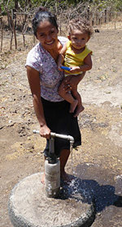 A pump for drinking water and limited use for irrigating gardens.
A pump for drinking water and limited use for irrigating gardens.
The EMAS Flexi-pump is a direct action pump initially developed in Bolivia. It uses a simple pumping principle. It consists of two PE-pipes (diameter approx. 5 cm) put into one another, one slightly larger than the other. At the bottom of each pipe is a non-return valve (glass ball). A metal pipe with a T-fitting serves as handle of the pump. One side of the T has a blind nipple and the other has a discharge nipple with elbow downward. A hose can be attached to this outlet so that water can be transported away from the pump up to 300m. The pumping movement raises and lowers the inner pipe. The outer pipe remains still. When the inner pipe is raised it lifts the water contained within it. Each stroke lifts the water in the inner pipe to the top until it runs out through the T-handle. The pump is self-priming. The EMAS Flexi pump is less resistant to very intensive use and mistreatment than metal pumps. It is designed as family pump for serving user groups of about 20 to 50 people. It can be used for irrigation of family gardens. Like all direct action pump the operation is not ergonomically favourable, therefore prolonged pumping is not possible.
Materials used
All components are made from commercially available materials, using two (glass) marbles, simple PVC pipes, thread adapters and (galvanized) iron pipe, available in any hardware store.
Installation and Maintenance
The installation of the EMAS Flexi pump is easy and does not need any lifting equipment or special tools. The pumps are generally installed in boreholes drilled with the EMAS-Concept of drilling.
Can be built and repaired by users themselves. Very cheap (less than one tenth of a rope pump in Nicaragua)
Manufacturing
Rural people are easily taught to build their own, Having built their own pump, people are able to maintain it forever. Only basic hand tools required.
The building of a pump takes approx. 3 hours and costs for materials are approx. USD 20 for a 10 meter pump.
Technical details
| Pumping depth (Lift) | up to 20m lift and a further 20m |
| Cylinder dia: |
28 mm to 42 mm, depending on depth |
| Stroke: | variable |
| Yield: (75 watt input, at 5 m head) | ~ 2.5 m³/hour |
| Population served: | 20-50 |
| Type of well: | dug well or borehole |
Costs
Approx USD 20 -30 excluding the borehole tube well (depending on installation depth, local material and labour costs)
Numbers
Some 20,000 EMAS pumps are in use in Bolivia and some 10,000 in Brazil. It is used in Peru, Equator and Nicaragua. In Asia and Africa, hundreds are in use.
Documentation
BAUMANN, E. (2011) Low Cost Handpumps. RWSN Field Note 2011-3 , RWSN , St Gallen, Switzerland
BRAND, A. P. (2004) Low-cost pump alternatives for rural communities in Honduras. Meeting demand for access to safe drinking water , Water and Sanitation Program (WSP) , Lima, Peru
Further Information
 Google Übersetzer
Google Übersetzer
